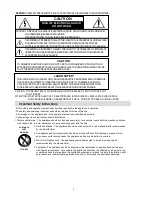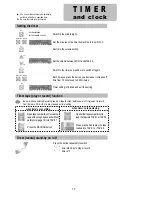
POWER SERVICING GROUNDING
ELECTRODE SYSTEM
(NEC ART 250, PART H)
6.
7.
8.
9.
10.
11.
12.
13.
14.
15.
16.
17.
Heat - The appliance should be situated away from heat sources such as radiators, heat registers, stoves, or other
appliances (including amplifiers) that produce heat.
Power Sources -The appliance should be connected to a power supply only of the type described in the operating
instructions or as marked on the appliance.
Grounding or Polarisation -The precautions that should be taken so that the grounding or polarisation means of
an appliance is not defeated.
Power - Cord Protection - Power-supply cords should be routed so that they are not likely to be walked on or
pinched by items placed upon or against them, paying particular attention to cords at plugs, convenience
receptacles, and the point where they exit from the appliance.
Protective Attachment Plug - If the appliance is equipped with an attachment plug having overload protection. This
is a safety feature. See Instruction Manual for replacement or resetting of protective device. If replacement of
the plug is required, be sure the service technician has used a replacement plug specified by the manufacturer
that has same overload protection as the original plug.
Cleaning - The appliance should be cleaned only as recommended by the manufacturer.
Power Lines - An outdoor antenna should be located away from power lines.
Outdoor Antenna Grounding - If an outside antenna is connected to the receiver be sure the antenna system is
grounded so as to provide some protection against voltage surges and built-up static charges. Article 810 of the
National Electrical Code, ANSI/NFPA 70, provides information with regard to proper grounding of the mast and
supporting structure, grounding of the lead-in wire to and antenna-discharge unit, size of grounding conductors,
location of antenna-discharge unit, connection to grounding electrodes and requirements for the grounding
electrode. See Figure 1.
Non-use Periods -The power cord of the appliance should be unplugged from the outlet when left unused for a
long period of time.
Object and Liquid Entry - Care should be taken so that objects do not fall and liquids are not spilled into the
enclosure through openings.
Damage Requiring Service -The appliance should be serviced by qualified service personnel when:
a) The power-supply cord or the plug has been damaged; or
b) Objects have fallen, or liquid has been spilled into the appliance; or
c) The appliance has been exposed to rain; or
d) The appliance does not appear to operate normally or exhibits a marked change in performance; or
e) The appliance has been dropped, or the enclosure damaged.
Servicing -The user should not attempt to service the appliance beyond that described in the operating
instructions. All other servicing should be referred to qualified service personnel.
FIGURE 1
EXAMPLE OF ANTENNA GROUNDING
AS PER NATIONAL
ELECTRICAL CODE
ANTENNA
LEAD IN
WIRE
ANTENNA
DISCHARGE UNIT
(NEC SECTION 810-20)
GROUND CLAMPS
NEC NATIONAL ELECTRICAL CODE
3
GROUNDING CONDUCTORS
(NEC SECTION 810-31)




































